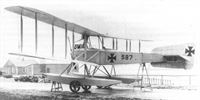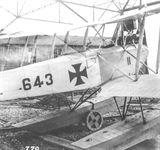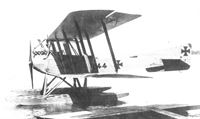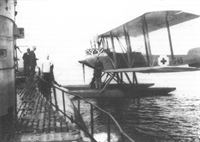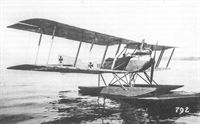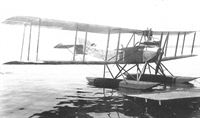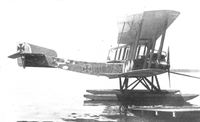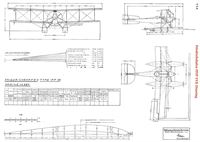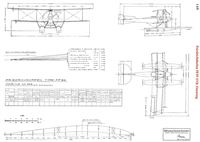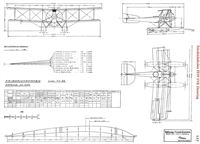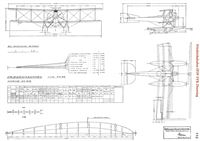
Описание
Страна: Германия
Год: 1916
Two-seat reconnaissance patrol twin-float seaplane
Варианты
- Friedrichshafen - FF19 - 1914 - Германия
- Friedrichshafen - FF29 - 1914 - Германия
- Friedrichshafen - FF33 - 1915 - Германия
- Friedrichshafen - FF39 - 1916 - Германия
- Friedrichshafen - FF49 - 1917 - Германия
- Friedrichshafen - FF59 - 1918 - Германия
- Friedrichshafen - FF67 - 1918 - Германия
- Friedrichshafen - FF71 - 1919 - Германия
- В.Обухович, А.Никифоров Самолеты Первой Мировой войны
- O.Thetford, P.Gray German Aircraft of the First World War (Putnam)
- J.Herris Friedrichshafen Aircraft of WWI (A Centennial Perspective on Great War Airplanes 21)
- M.Dusing German Aviation Industry in WWI. Volume 2 (A Centennial Perspective on Great War Airplanes 85)
- Журнал Flight
-
J.Herris - Friedrichshafen Aircraft of WWI /Centennial Perspective/ (21)
Marine Number 587 ordered in December 1915 was the prototype FF39. Powered by a 200 hp Benz Bz.IV, the FF39 was a class CHFT floatplane. A total of 14 of these aircraft were built. (The Peter M. Bowers Collection/The Museum of Flight)
-
J.Herris - Friedrichshafen Aircraft of WWI /Centennial Perspective/ (21)
The prototype FF39 displays its clean lines for a reconnaissance floatplane. (The Peter M. Bowers Collection/The Museum of Flight)
-
J.Herris - Friedrichshafen Aircraft of WWI /Centennial Perspective/ (21)
Ordered in December 1915, first flight of the prototype FF39 was in December 1916 and it was delivered about 25 March 1917. The prolonged development time was probably due to delayed availability of the Benz Bz.IV engine. (The Peter M. Bowers Collection/The Museum of Flight)
-
M.Dusing - German Aviation Industry in WWI. Volume 2 /Centennial Perspective/ (85)
Final assembly of FF39 (587) and FF33E (721) in the old Zeppelin hangar in Manzell near Friedrichshafen.
Другие самолёты на фотографии: Friedrichshafen FF33 - Германия - 1915
-
J.Herris - Friedrichshafen Aircraft of WWI /Centennial Perspective/ (21)
Prototype FF39 #587.
-
J.Herris - Friedrichshafen Aircraft of WWI /Centennial Perspective/ (21)
Fdh FF39 (1915). The design of the FF39 was created by Th. Kober at the end of 1916 (first flight of the prototype MNo. 587 took place in December 1916). 14 seaplanes of this type were delivered to the Imperial Navy. The prototype (#587) was an FF33J equipped with a Benz Bz.IV. The necessary compensation due to the heavier engine was achieved by mounting the upper wing staggered forward.
The prototype FF39 did not have any wing stagger and featured typical Friedrichshafen lines. (The Peter M. Bowers Collection/The Museum of Flight) -
O.Thetford, P.Gray - German Aircraft of the First World War /Putnam/
Friedrichshafen FF 39
-
O.Thetford, P.Gray - German Aircraft of the First World War /Putnam/
Fdh FF39C (1915/16).
-
J.Herris - Friedrichshafen Aircraft of WWI /Centennial Perspective/ (21)
Marine Number 643 was the first production FF39. Unlike the prototype, production FF39 aircraft had wing stagger. On 30 September 1917 this aircraft crashed and burned on landing, killing both crewmen. It was attached to Zeebrugge naval air station at the time.
-
J.Herris - Friedrichshafen Aircraft of WWI /Centennial Perspective/ (21)
FF39 #644 with no spinner wears the late-war camouflage. (The Peter M. Bowers Collection/The Museum of Flight)
-
J.Herris - Friedrichshafen Aircraft of WWI /Centennial Perspective/ (21)
In 1918 FF39 #645, with Ltn.z.S. Wolfram Eisenlohr as observer, rendezvouses with a submarine one of Eisenlohr's brothers was serving aboard. Eisenlohr sank the Russian destroyer Stroini with bombs while flying FF41 AT MN 1000.
-
J.Herris - Friedrichshafen Aircraft of WWI /Centennial Perspective/ (21)
FF39 Marine Number 1127, the first aircraft of the main production batch, wears an interesting, non-standard camouflage scheme. These photos show it with no spinner. (Top photo The Peter M. Bowers Collection/The Museum of Flight)
-
J.Herris - Friedrichshafen Aircraft of WWI /Centennial Perspective/ (21)
FF39 Marine Number 1131 of the main production batch taxies on the water. As is evident here, the aircraft of the main production batch were rigged with pronounced wing stagger.
-
A.Durkota, T.Darcey, V.Kulikov - The Imperial Russian Air Service /Flying Machines/
A German Friedrichshafen FF39, two Sablatnig SF5s, and a Friedrichshafen FF33 seaplane at Windau, Courland, October 1917.
Sablatnig SF5 seaplanes in operation at the Naval Air Station at Libau.Другие самолёты на фотографии: Friedrichshafen FF33 - Германия - 1915Sablatnig SF.1/SF.2/SF.5/B.I - Германия - 1916
-
J.Herris - Friedrichshafen Aircraft of WWI /Centennial Perspective/ (21)
Friedrichshafen FF39 SVK Drawing
-
J.Herris - Friedrichshafen Aircraft of WWI /Centennial Perspective/ (21)
Friedrichshafen FF39 SVK Drawing
-
J.Herris - Friedrichshafen Aircraft of WWI /Centennial Perspective/ (21)
Friedrichshafen FF39 SVK Drawing
-
J.Herris - Friedrichshafen Aircraft of WWI /Centennial Perspective/ (21)
Friedrichshafen FF39 SVK Drawing
В.Обухович, А.Никифоров Самолеты Первой Мировой войны
В процессе производства самолет FF 33 был серьезно модернизирован. Так в 1917 г. был создан FF 39 - улучшенный вариант FF 33e несколько больших размеров с двигателем Бенц Bz.IV (200 л, с), Он дополнительно производился по лицензии двумя компаниями. В общей сложности было построено 235 машин. Самолеты обладали очень надежной конструкцией. Один из них, после вынужденной посадки на воду в Северном море, дрейфовал в неспокойном море более пяти суток и был обнаружен рыбаками в 60 км от Норвегии. Самолет почти не был поврежден.
Описание:



